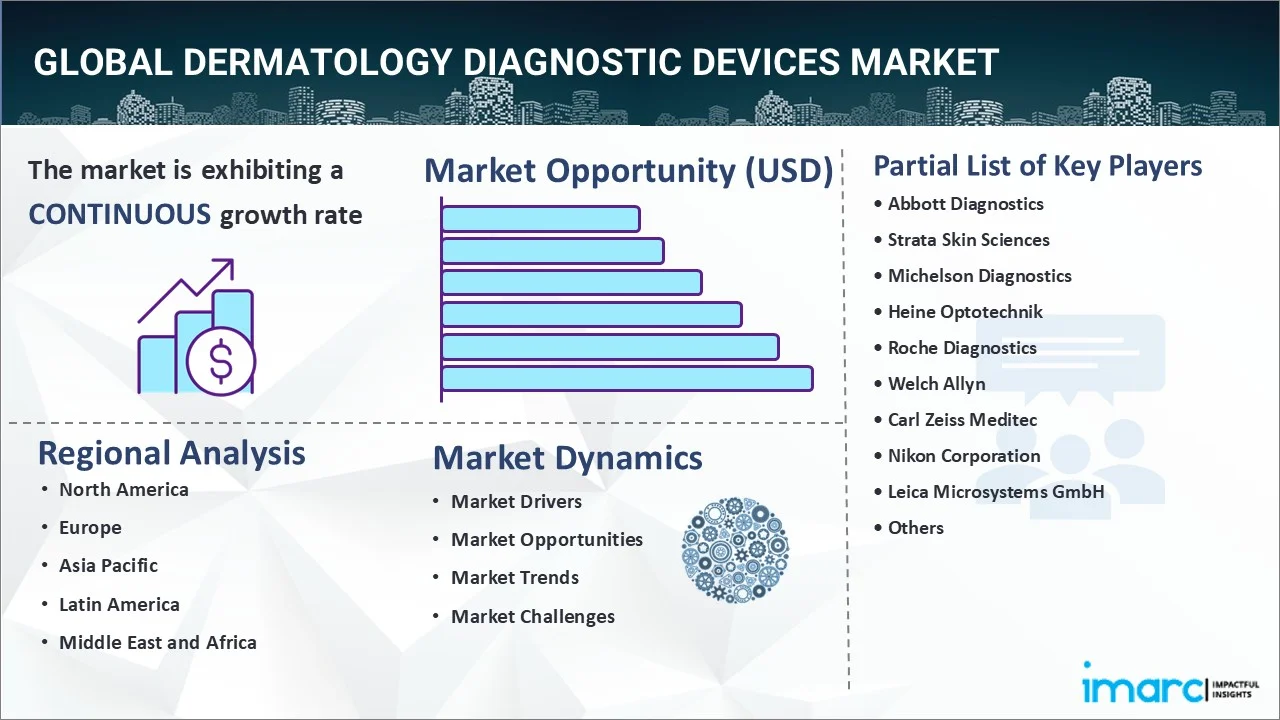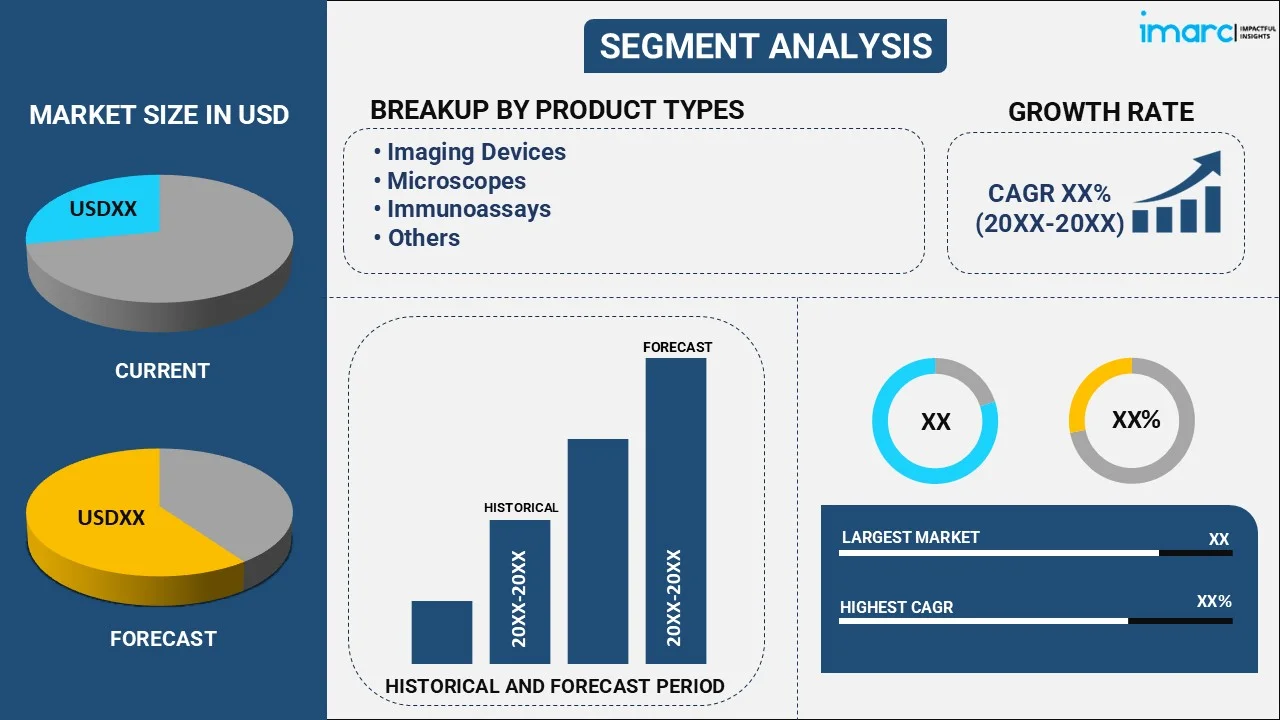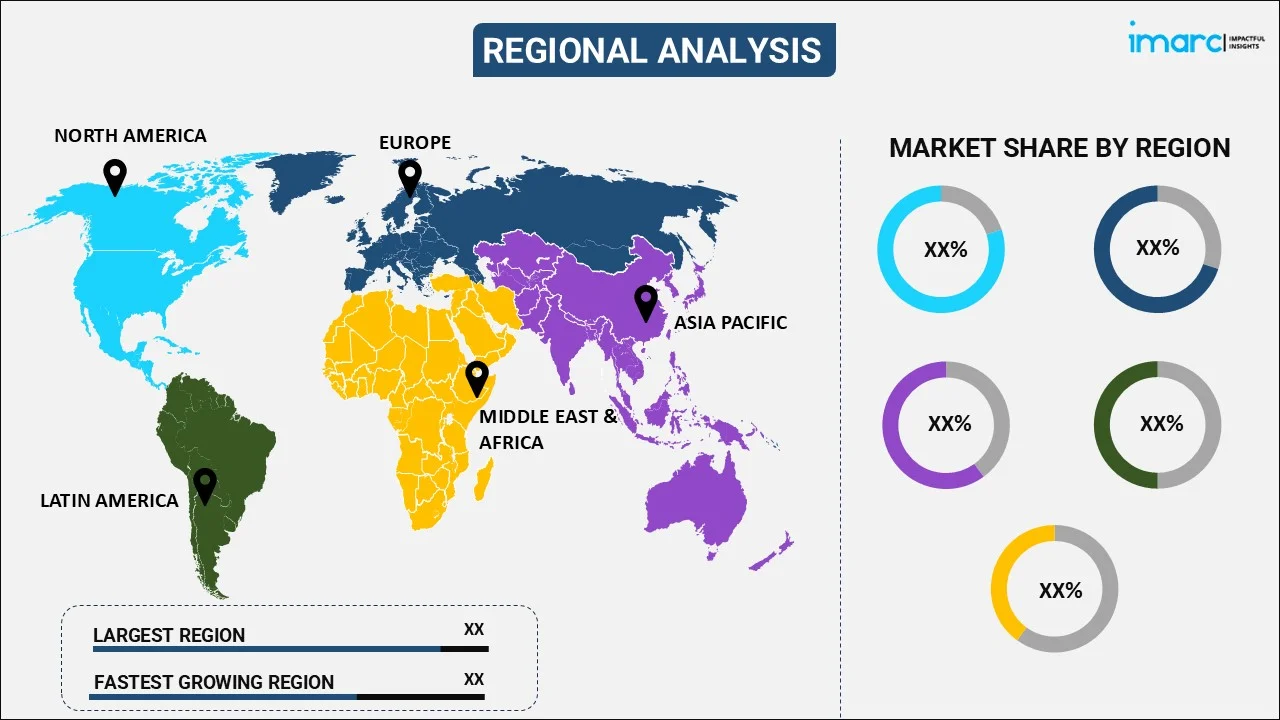
Dermatology Diagnostic Devices Market Report by Product Type (Imaging Devices, Microscopes, Immunoassays, Molecular Diagnostics, and Others), End Use (Hospitals, Diagnostic Labs, and Others), and Region 2025-2033
Market Overview:
The global dermatology diagnostic devices market size reached USD 17.5 Billion in 2024. Looking forward, IMARC Group expects the market to reach USD 36.6 Billion by 2033, exhibiting a growth rate (CAGR) of 8.13% during 2025-2033. The growing prevalence of skin disorders, increasing demand for non-invasive surgical methods, and rising number of specialty clinics and hospitals represent some of the key factors driving the market.
|
Report Attribute
|
Key Statistics
|
|---|---|
|
Base Year
|
2024
|
|
Forecast Years
|
2025-2033
|
|
Historical Years
|
2019-2024
|
|
Market Size in 2024
|
USD 17.5 Billion |
|
Market Forecast in 2033
|
USD 36.6 Billion |
| Market Growth Rate 2025-2033 | 8.13% |
Technological Advancements Propelling Market Growth
Various technological advancements represent one of the primary drivers resulting in the increasing demand for dermatology diagnostic devices. The rising focus on enhancing the accuracy and sensitivity of the detection mechanism in dermatology devices is strengthening the growth of the market. In addition, the introduction of a digital dermatoscope for detecting the early signs of non-malignant melanomas is positively influencing the market. In addition to this, various mobile-based technologies for dermatology diagnosis are available in the market that easily screen and track various skin conditions. Also, the integration of artificial intelligence (AI) in dermatology diagnostic devices for early skin cancer is impelling the market growth.

Competitive analysis such as market structure, market share by key players, player positioning, top winning strategies, competitive dashboard, and company evaluation quadrant has been covered in the report. Also, detailed profiles of all major companies have been provided. The market structure is concentrated in nature with few large-scale accounting for the majority of the market share. The volume of new entrants is moderate in the dermatology diagnostic devices industry due to the high capital investments and exit barriers.
What are Dermatology Diagnostic Devices?
Dermatology diagnostic devices comprise imaging, microscopes, immunoassays, and molecular diagnostics devices. They are widely available in different sizes, shapes, and additional features as per the disease type. They involve various technologies, such as X-rays and computed tomography (CT) scans to observe and diagnose skin ailments. They offer enhanced accuracy and aid in improving treatment efficacy while reducing the chances of reoccurrences. They are used to perform a visual examination and microscopic observation of the skin, which assists in identifying the disease and specifying a treatment plan. They are also utilized to treat acne, wounds, skin tumors, scabies, hair loss, fungal infection, pigmentation, skin cancer, skin lesions, scalp problems, and melanoma among individuals. As a result, dermatology diagnostics devices are employed in hospitals, diagnostic labs, and specialty skin care centers across the globe.
COVID-19 Impact:
The COVID-19 pandemic outbreak has caused a problem for the dermatology diagnostic devices industry and imposed unprecedented challenges on numerous countries. Dermatology diagnostic devices are essential products, and their production facilities were continued during the lockdown period. The manufacturing of dermatology diagnostic devices has been affected in the initial period of the pandemic due to supply chain disruptions from raw materials, labor shortages, and low stocks. In addition, due to the lockdown and imposition of social distancing norms, various manufacturers have downscaled capacity or paused their production. Import of raw materials for dermatology diagnostic devices has reduced due to the global pandemic crisis. Besides this, the demand for dermatology diagnostics devices has been hampered during the pandemic due to a sharp reduction in non-emergency visits to hospitals and clinics. The rising preference for online consultations has been observed among individuals around the world. Moreover, non-essential surgeries have been postponed, impacting the demand for dermatology diagnostics devices. Furthermore, various strategic plans and projects of the key players have been postponed or canceled due to the widespread coronavirus across the globe.
Dermatology Diagnostic Devices Market Trends:
At present, the rising demand for dermatology diagnostic devices due to the increasing prevalence of skin disorders, such as hair fall, psoriasis, and eczema, among the masses represents one of the key factors supporting the growth of the market. Besides this, the growing popularity of dermatology procedures in the cosmetic industry to treat skin pigmentations, allergic reactions, and fungal and bacterial infections among individuals is offering a positive market outlook. Additionally, there is a rise in the need for smaller and easy-to-use devices in hospitals and clinics around the world. This, coupled with the increasing utilization of dermatology diagnostic devices to detect early signs of diseases among individuals, is propelling the growth of the market. Apart from this, the rising demand for non-invasive surgical methods among individuals worldwide is offering lucrative growth opportunities to industry investors. Moreover, the increasing number of specialty clinics and hospitals across the globe is positively influencing the market. In addition, the rising utilization of mobile-based technologies for dermatology diagnosis that can track and screen skin conditions is contributing to the growth of the market. Furthermore, key players are introducing devices that perform imaging techniques, such as dermatoscopy and optical coherence tomography, which is strengthening the market growth.
Key Market Segmentation:
IMARC Group provides an analysis of the key trends in each sub-segment of the global dermatology diagnostic devices market report, along with forecasts at the global and regional level from 2025-2033. Our report has categorized the market based on product type and end-use.
Product Type Insights:

- Imaging Devices
- Microscopes
- Immunoassays
- Molecular Diagnostics
- Others
The report has provided a detailed breakup and analysis of the dermatology diagnostic devices market based on the product type. This includes imaging devices, microscopes, immunoassays, molecular diagnostics, and others. According to the report, imaging devices represented the largest segment as they assist dermatologists in detecting skin diseases at an early phase and implementing appropriate medication and treatment. In addition, the wide availability of imaging devices that are used for dermatological examinations, such as point-and-shoot cameras, OCT and quantitative thermographic imaging (QTI), interchangeable lens system cameras and smartphone/tablet attachments, is propelling the market growth.
End Use Insights:
- Hospitals
- Diagnostic Labs
- Others
A detailed breakup and analysis of the dermatology diagnostic devices market based on the end use has also been provided in the report. This includes hospitals, diagnostic labs, and others. According to the report, hospitals accounted for the largest market share as dermatology is an essential healthcare service provided under ambulatory care services of a hospital and dermatologists offer treatment services and consultations to patients. In addition, the wide availability of well-equipped dermatology departments and specialists in hospitals due to the rising number of patients requiring surgical, cosmetic, and aesthetic procedures.
Regional Insights:

- North America
- Europe
- Asia Pacific
- Middle East and Africa
- Latin America
The report has also provided a comprehensive analysis of all the major regional markets, which include North America, Europe, Asia Pacific, the Middle East and Africa, and Latin America. According to the report, North America was the largest market for dermatology diagnostic devices. Some of the factors driving the North America dermatology diagnostic devices market included the rising prevalence of chronic skin disorders, such as psoriasis and melanoma among individuals. In addition, the increasing demand for accurate diagnosis due to poor survival rate of late diagnosis for melanoma and the growing awareness about the availability of non-invasive aesthetic procedures among individuals are bolstering the market growth in the region.
Competitive Landscape:
The report has also provided a comprehensive analysis of the competitive landscape in the global dermatology diagnostic devices market. Some of the companies covered in the report include:
- Abbott Diagnostics
- Strata Skin Sciences
- Michelson Diagnostics
- Heine Optotechnik
- Roche Diagnostics
- Welch Allyn
- Carl Zeiss Meditec
- Nikon Corporation
- Leica Microsystems GmbH
- MELA Sciences, Inc.
- GE Healthcare Ltd.
- Bruker Corporation
- Philips Healthcare
- Siemens Healthcare Diagnostics Inc.
- Toshiba Medical Systems Corporation
- Photomedex, Inc.
Please note that this only represents a partial list of companies, and the complete list has been provided in the report.
Report Coverage:
| Report Features | Details |
|---|---|
| Base Year of the Analysis | 2024 |
| Historical Period | 2019-2024 |
| Forecast Period | 2025-2033 |
| Units | Billion USD |
| Segment Coverage | Product Type, End-Use, Region |
| Region Covered | Asia Pacific, Europe, North America, Latin America, Middle East and Africa |
| Companies Covered | Abbott Diagnostics, Strata Skin Sciences, Michelson Diagnostics, Heine Optotechnik, Roche Diagnostics, Welch Allyn, Carl Zeiss Meditec, Nikon Corporation, Leica Microsystems GmbH, MELA Sciences, Inc., GE Healthcare Ltd., Bruker Corporation, Philips Healthcare, Siemens Healthcare Diagnostics Inc., Toshiba Medical Systems Corporation and Photomedex, Inc. |
| Customization Scope | 10% Free Customization |
| Post-Sale Analyst Support | 10-12 Weeks |
| Delivery Format | PDF and Excel through Email (We can also provide the editable version of the report in PPT/Word format on special request) |
Key Questions Answered in This Report:
- How has the global dermatology diagnostic devices market performed so far, and how will it perform in the coming years?
- What are the drivers, restraints, and opportunities in the global dermatology diagnostic devices market?
- What is the impact of each driver, restraint, and opportunity on the global dermatology diagnostic devices market?
- What are the key regional markets?
- What is the breakup of the market based on the product type?
- Which is the most attractive product type in the dermatology diagnostic devices market?
- What is the breakup of the market based on the end use?
- Which is the most attractive end use in the dermatology diagnostic devices market?
- What is the competitive structure of the global dermatology diagnostic devices market?
- Who are the key players/companies in the global dermatology diagnostic devices market?
Key Benefits for Stakeholders:
- IMARC’s report offers a comprehensive quantitative analysis of various market segments, historical and current market trends, market forecasts, and dynamics of the dermatology diagnostic devices market from 2019-2033.
- The research study provides the latest information on the market drivers, challenges, and opportunities in the global dermatology diagnostic devices market.
- The study maps the leading, as well as the fastest-growing, regional markets.
- Porter's five forces analysis assist stakeholders in assessing the impact of new entrants, competitive rivalry, supplier power, buyer power, and the threat of substitution. It helps stakeholders to analyze the level of competition within the dermatology diagnostic devices industry and its attractiveness.
- Competitive landscape allows stakeholders to understand their competitive environment and provides an insight into the current positions of key players in the market.
Need more help?
- Speak to our experienced analysts for insights on the current market scenarios.
- Include additional segments and countries to customize the report as per your requirement.
- Gain an unparalleled competitive advantage in your domain by understanding how to utilize the report and positively impacting your operations and revenue.
- For further assistance, please connect with our analysts.
 Inquire Before Buying
Inquire Before Buying
 Speak to an Analyst
Speak to an Analyst
 Request Brochure
Request Brochure
 Request Customization
Request Customization




.webp)




.webp)












